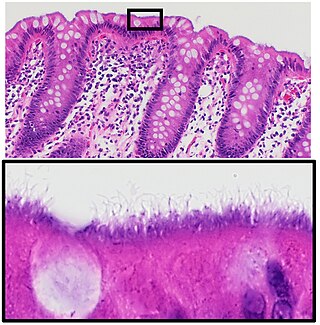Top Qs
Timeline
Chat
Perspective
Intestinal spirochetosis
Medical condition From Wikipedia, the free encyclopedia
Remove ads
Human intestinal spirochetosis, often called just intestinal spirochetosis when the human context is implicit, is an infection of the colonic-type mucosa with certain species of spirochetal bacteria. Similar infections sometimes occur in pigs, dogs, and birds; porcine intestinal spirochaetosis is an economically important disease of livestock.
Remove ads
Signs and symptoms
No clear association exists with complaints. However, potential associations include abdominal pain and watery diarrhea, which may be seen with blood; however, these findings are not specific and may be due to a number of other causes.[2]
Cause
Human intestinal spirochetosis is caused by Brachyspira pilosicoli and Brachyspira aalborgi.[3] Porcine and avian intestinal spirochetosis are caused by Brachyspira hyodysenteriae and Brachyspira pilosicoli.[citation needed]
Diagnosis

It is diagnosed by examination of tissue, i.e., biopsy. A hallmark finding is the presence of a “false brush border” on the luminal surface of the epithelium, formed by dense linear colonization of spirochetes.[4]
Management
This section needs additional citations for verification. (March 2024) |
Symptomatic individuals can be treated with oral metronidazole.
See also
References
Wikiwand - on
Seamless Wikipedia browsing. On steroids.
Remove ads

